Research Proposal: Strategies for Equality and Diversity at Tesco
VerifiedAdded on 2023/01/12
|8
|2555
|97
Report
AI Summary
This research proposal investigates strategies to combat workplace discrimination at Tesco, aiming to create an equal and diverse working environment. The introduction highlights the importance of equality and diversity in the modern workplace, especially within multinational corporations like Tesco, and the negative impacts of discrimination on employee performance and company goals. The research aims to identify and analyze strategies that can reduce workplace discrimination, including understanding the concepts of equality and diversity, evaluating the existence of discrimination within the company, and recommending implementation methods. The literature review explores the concepts of equality and diversity, methods for identifying discrimination, and various strategies to mitigate it, such as written policies, training programs, and fair treatment. The methodology section outlines the research approach, including qualitative and quantitative methods, a deductive approach, interpretivism philosophy, and the use of secondary data and questionnaires. The ethical considerations emphasize the importance of ethical practices and principles, ensuring the reliability and trustworthiness of the research results, and protecting the interests of all stakeholders. The anticipated outcomes include increased knowledge of equality and diversity, enhanced research skills, and actionable strategies for Tesco to implement. The proposal seeks to contribute to a more inclusive and productive work environment for all employees.

Research Proposal
Paraphrase This Document
Need a fresh take? Get an instant paraphrase of this document with our AI Paraphraser
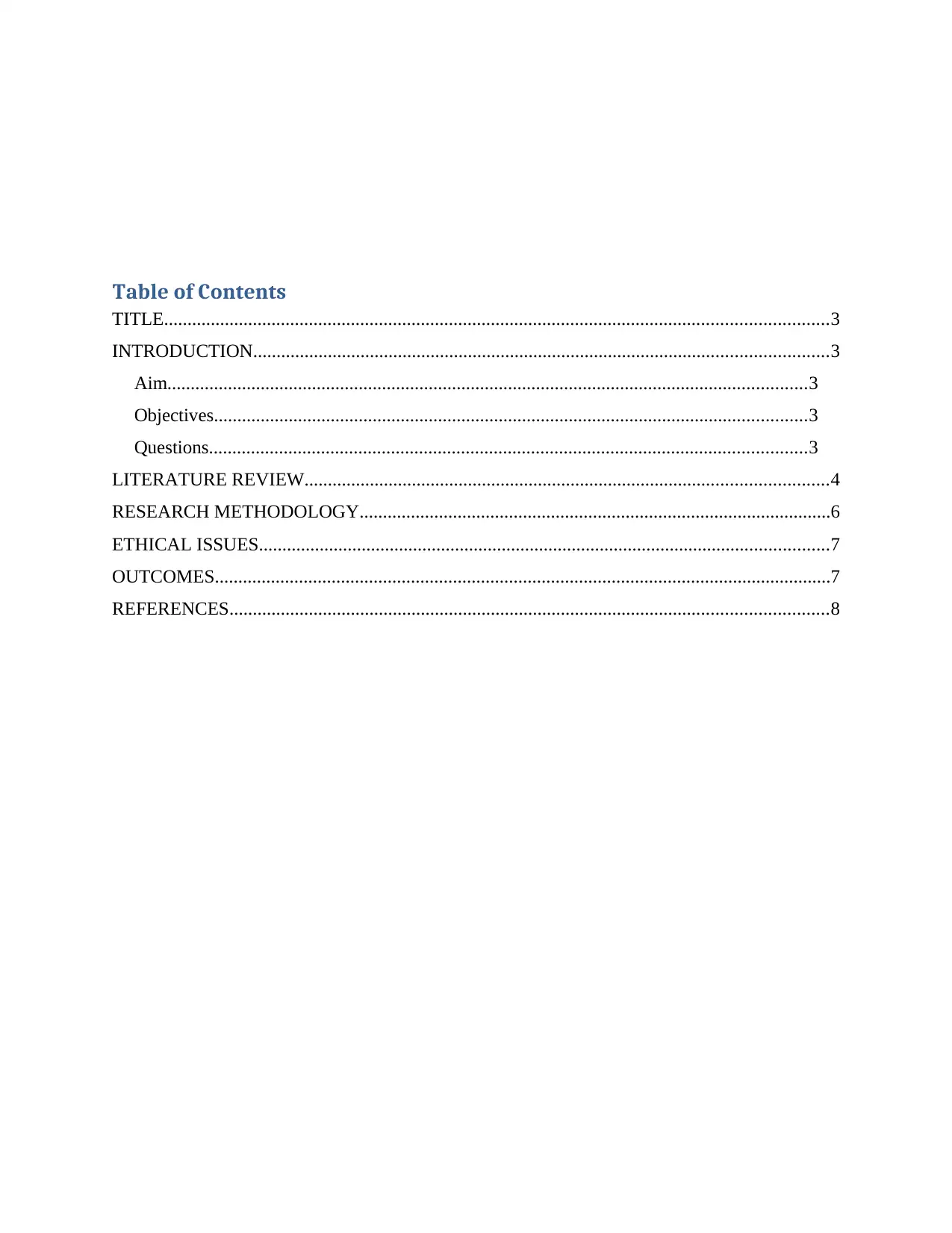
Table of Contents
TITLE..............................................................................................................................................3
INTRODUCTION...........................................................................................................................3
Aim.........................................................................................................................................3
Objectives...............................................................................................................................3
Questions................................................................................................................................3
LITERATURE REVIEW................................................................................................................4
RESEARCH METHODOLOGY.....................................................................................................6
ETHICAL ISSUES..........................................................................................................................7
OUTCOMES....................................................................................................................................7
REFERENCES................................................................................................................................8
TITLE..............................................................................................................................................3
INTRODUCTION...........................................................................................................................3
Aim.........................................................................................................................................3
Objectives...............................................................................................................................3
Questions................................................................................................................................3
LITERATURE REVIEW................................................................................................................4
RESEARCH METHODOLOGY.....................................................................................................6
ETHICAL ISSUES..........................................................................................................................7
OUTCOMES....................................................................................................................................7
REFERENCES................................................................................................................................8
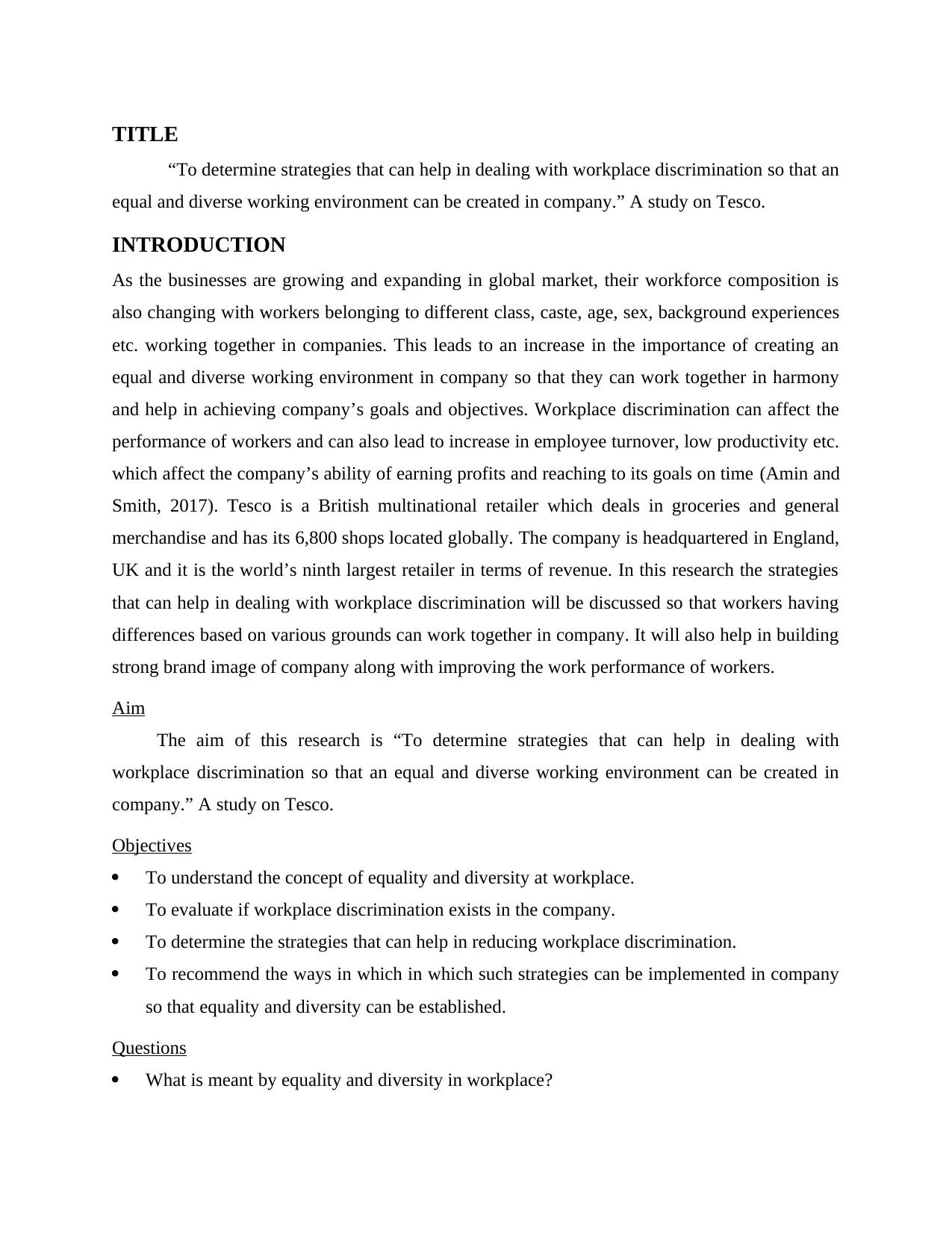
TITLE
“To determine strategies that can help in dealing with workplace discrimination so that an
equal and diverse working environment can be created in company.” A study on Tesco.
INTRODUCTION
As the businesses are growing and expanding in global market, their workforce composition is
also changing with workers belonging to different class, caste, age, sex, background experiences
etc. working together in companies. This leads to an increase in the importance of creating an
equal and diverse working environment in company so that they can work together in harmony
and help in achieving company’s goals and objectives. Workplace discrimination can affect the
performance of workers and can also lead to increase in employee turnover, low productivity etc.
which affect the company’s ability of earning profits and reaching to its goals on time (Amin and
Smith, 2017). Tesco is a British multinational retailer which deals in groceries and general
merchandise and has its 6,800 shops located globally. The company is headquartered in England,
UK and it is the world’s ninth largest retailer in terms of revenue. In this research the strategies
that can help in dealing with workplace discrimination will be discussed so that workers having
differences based on various grounds can work together in company. It will also help in building
strong brand image of company along with improving the work performance of workers.
Aim
The aim of this research is “To determine strategies that can help in dealing with
workplace discrimination so that an equal and diverse working environment can be created in
company.” A study on Tesco.
Objectives
To understand the concept of equality and diversity at workplace.
To evaluate if workplace discrimination exists in the company.
To determine the strategies that can help in reducing workplace discrimination.
To recommend the ways in which in which such strategies can be implemented in company
so that equality and diversity can be established.
Questions
What is meant by equality and diversity in workplace?
“To determine strategies that can help in dealing with workplace discrimination so that an
equal and diverse working environment can be created in company.” A study on Tesco.
INTRODUCTION
As the businesses are growing and expanding in global market, their workforce composition is
also changing with workers belonging to different class, caste, age, sex, background experiences
etc. working together in companies. This leads to an increase in the importance of creating an
equal and diverse working environment in company so that they can work together in harmony
and help in achieving company’s goals and objectives. Workplace discrimination can affect the
performance of workers and can also lead to increase in employee turnover, low productivity etc.
which affect the company’s ability of earning profits and reaching to its goals on time (Amin and
Smith, 2017). Tesco is a British multinational retailer which deals in groceries and general
merchandise and has its 6,800 shops located globally. The company is headquartered in England,
UK and it is the world’s ninth largest retailer in terms of revenue. In this research the strategies
that can help in dealing with workplace discrimination will be discussed so that workers having
differences based on various grounds can work together in company. It will also help in building
strong brand image of company along with improving the work performance of workers.
Aim
The aim of this research is “To determine strategies that can help in dealing with
workplace discrimination so that an equal and diverse working environment can be created in
company.” A study on Tesco.
Objectives
To understand the concept of equality and diversity at workplace.
To evaluate if workplace discrimination exists in the company.
To determine the strategies that can help in reducing workplace discrimination.
To recommend the ways in which in which such strategies can be implemented in company
so that equality and diversity can be established.
Questions
What is meant by equality and diversity in workplace?
⊘ This is a preview!⊘
Do you want full access?
Subscribe today to unlock all pages.

Trusted by 1+ million students worldwide
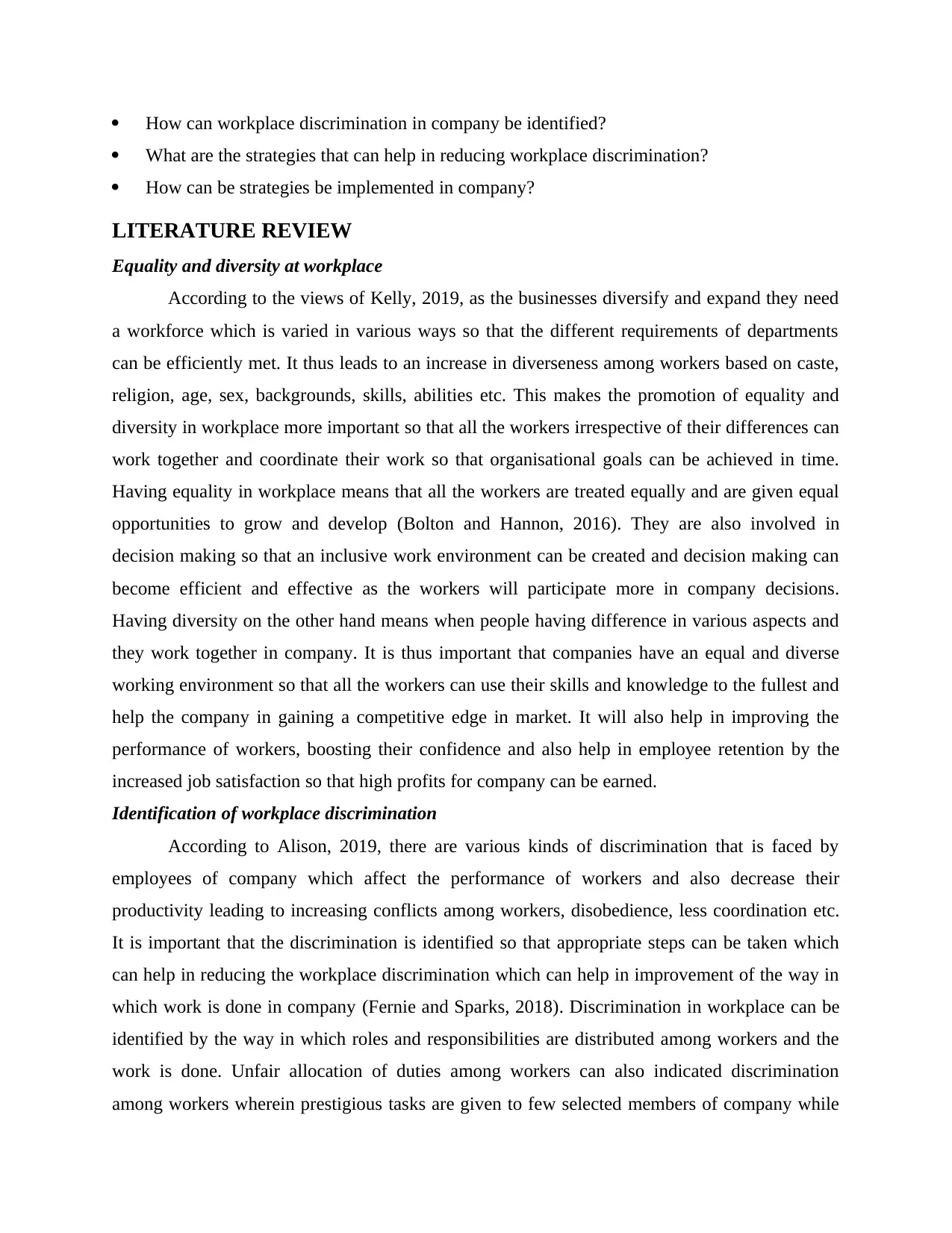
How can workplace discrimination in company be identified?
What are the strategies that can help in reducing workplace discrimination?
How can be strategies be implemented in company?
LITERATURE REVIEW
Equality and diversity at workplace
According to the views of Kelly, 2019, as the businesses diversify and expand they need
a workforce which is varied in various ways so that the different requirements of departments
can be efficiently met. It thus leads to an increase in diverseness among workers based on caste,
religion, age, sex, backgrounds, skills, abilities etc. This makes the promotion of equality and
diversity in workplace more important so that all the workers irrespective of their differences can
work together and coordinate their work so that organisational goals can be achieved in time.
Having equality in workplace means that all the workers are treated equally and are given equal
opportunities to grow and develop (Bolton and Hannon, 2016). They are also involved in
decision making so that an inclusive work environment can be created and decision making can
become efficient and effective as the workers will participate more in company decisions.
Having diversity on the other hand means when people having difference in various aspects and
they work together in company. It is thus important that companies have an equal and diverse
working environment so that all the workers can use their skills and knowledge to the fullest and
help the company in gaining a competitive edge in market. It will also help in improving the
performance of workers, boosting their confidence and also help in employee retention by the
increased job satisfaction so that high profits for company can be earned.
Identification of workplace discrimination
According to Alison, 2019, there are various kinds of discrimination that is faced by
employees of company which affect the performance of workers and also decrease their
productivity leading to increasing conflicts among workers, disobedience, less coordination etc.
It is important that the discrimination is identified so that appropriate steps can be taken which
can help in reducing the workplace discrimination which can help in improvement of the way in
which work is done in company (Fernie and Sparks, 2018). Discrimination in workplace can be
identified by the way in which roles and responsibilities are distributed among workers and the
work is done. Unfair allocation of duties among workers can also indicated discrimination
among workers wherein prestigious tasks are given to few selected members of company while
What are the strategies that can help in reducing workplace discrimination?
How can be strategies be implemented in company?
LITERATURE REVIEW
Equality and diversity at workplace
According to the views of Kelly, 2019, as the businesses diversify and expand they need
a workforce which is varied in various ways so that the different requirements of departments
can be efficiently met. It thus leads to an increase in diverseness among workers based on caste,
religion, age, sex, backgrounds, skills, abilities etc. This makes the promotion of equality and
diversity in workplace more important so that all the workers irrespective of their differences can
work together and coordinate their work so that organisational goals can be achieved in time.
Having equality in workplace means that all the workers are treated equally and are given equal
opportunities to grow and develop (Bolton and Hannon, 2016). They are also involved in
decision making so that an inclusive work environment can be created and decision making can
become efficient and effective as the workers will participate more in company decisions.
Having diversity on the other hand means when people having difference in various aspects and
they work together in company. It is thus important that companies have an equal and diverse
working environment so that all the workers can use their skills and knowledge to the fullest and
help the company in gaining a competitive edge in market. It will also help in improving the
performance of workers, boosting their confidence and also help in employee retention by the
increased job satisfaction so that high profits for company can be earned.
Identification of workplace discrimination
According to Alison, 2019, there are various kinds of discrimination that is faced by
employees of company which affect the performance of workers and also decrease their
productivity leading to increasing conflicts among workers, disobedience, less coordination etc.
It is important that the discrimination is identified so that appropriate steps can be taken which
can help in reducing the workplace discrimination which can help in improvement of the way in
which work is done in company (Fernie and Sparks, 2018). Discrimination in workplace can be
identified by the way in which roles and responsibilities are distributed among workers and the
work is done. Unfair allocation of duties among workers can also indicated discrimination
among workers wherein prestigious tasks are given to few selected members of company while
Paraphrase This Document
Need a fresh take? Get an instant paraphrase of this document with our AI Paraphraser
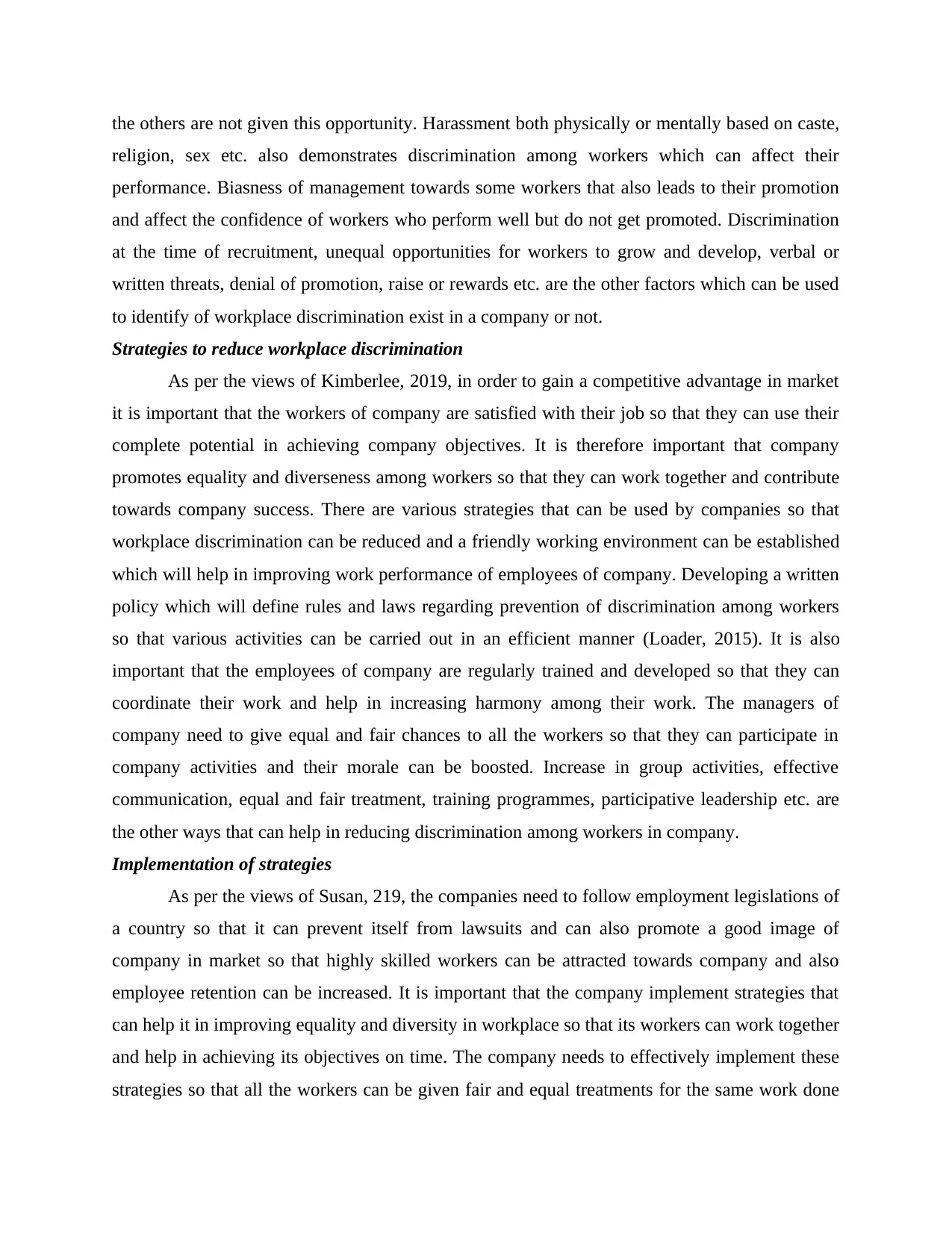
the others are not given this opportunity. Harassment both physically or mentally based on caste,
religion, sex etc. also demonstrates discrimination among workers which can affect their
performance. Biasness of management towards some workers that also leads to their promotion
and affect the confidence of workers who perform well but do not get promoted. Discrimination
at the time of recruitment, unequal opportunities for workers to grow and develop, verbal or
written threats, denial of promotion, raise or rewards etc. are the other factors which can be used
to identify of workplace discrimination exist in a company or not.
Strategies to reduce workplace discrimination
As per the views of Kimberlee, 2019, in order to gain a competitive advantage in market
it is important that the workers of company are satisfied with their job so that they can use their
complete potential in achieving company objectives. It is therefore important that company
promotes equality and diverseness among workers so that they can work together and contribute
towards company success. There are various strategies that can be used by companies so that
workplace discrimination can be reduced and a friendly working environment can be established
which will help in improving work performance of employees of company. Developing a written
policy which will define rules and laws regarding prevention of discrimination among workers
so that various activities can be carried out in an efficient manner (Loader, 2015). It is also
important that the employees of company are regularly trained and developed so that they can
coordinate their work and help in increasing harmony among their work. The managers of
company need to give equal and fair chances to all the workers so that they can participate in
company activities and their morale can be boosted. Increase in group activities, effective
communication, equal and fair treatment, training programmes, participative leadership etc. are
the other ways that can help in reducing discrimination among workers in company.
Implementation of strategies
As per the views of Susan, 219, the companies need to follow employment legislations of
a country so that it can prevent itself from lawsuits and can also promote a good image of
company in market so that highly skilled workers can be attracted towards company and also
employee retention can be increased. It is important that the company implement strategies that
can help it in improving equality and diversity in workplace so that its workers can work together
and help in achieving its objectives on time. The company needs to effectively implement these
strategies so that all the workers can be given fair and equal treatments for the same work done
religion, sex etc. also demonstrates discrimination among workers which can affect their
performance. Biasness of management towards some workers that also leads to their promotion
and affect the confidence of workers who perform well but do not get promoted. Discrimination
at the time of recruitment, unequal opportunities for workers to grow and develop, verbal or
written threats, denial of promotion, raise or rewards etc. are the other factors which can be used
to identify of workplace discrimination exist in a company or not.
Strategies to reduce workplace discrimination
As per the views of Kimberlee, 2019, in order to gain a competitive advantage in market
it is important that the workers of company are satisfied with their job so that they can use their
complete potential in achieving company objectives. It is therefore important that company
promotes equality and diverseness among workers so that they can work together and contribute
towards company success. There are various strategies that can be used by companies so that
workplace discrimination can be reduced and a friendly working environment can be established
which will help in improving work performance of employees of company. Developing a written
policy which will define rules and laws regarding prevention of discrimination among workers
so that various activities can be carried out in an efficient manner (Loader, 2015). It is also
important that the employees of company are regularly trained and developed so that they can
coordinate their work and help in increasing harmony among their work. The managers of
company need to give equal and fair chances to all the workers so that they can participate in
company activities and their morale can be boosted. Increase in group activities, effective
communication, equal and fair treatment, training programmes, participative leadership etc. are
the other ways that can help in reducing discrimination among workers in company.
Implementation of strategies
As per the views of Susan, 219, the companies need to follow employment legislations of
a country so that it can prevent itself from lawsuits and can also promote a good image of
company in market so that highly skilled workers can be attracted towards company and also
employee retention can be increased. It is important that the company implement strategies that
can help it in improving equality and diversity in workplace so that its workers can work together
and help in achieving its objectives on time. The company needs to effectively implement these
strategies so that all the workers can be given fair and equal treatments for the same work done
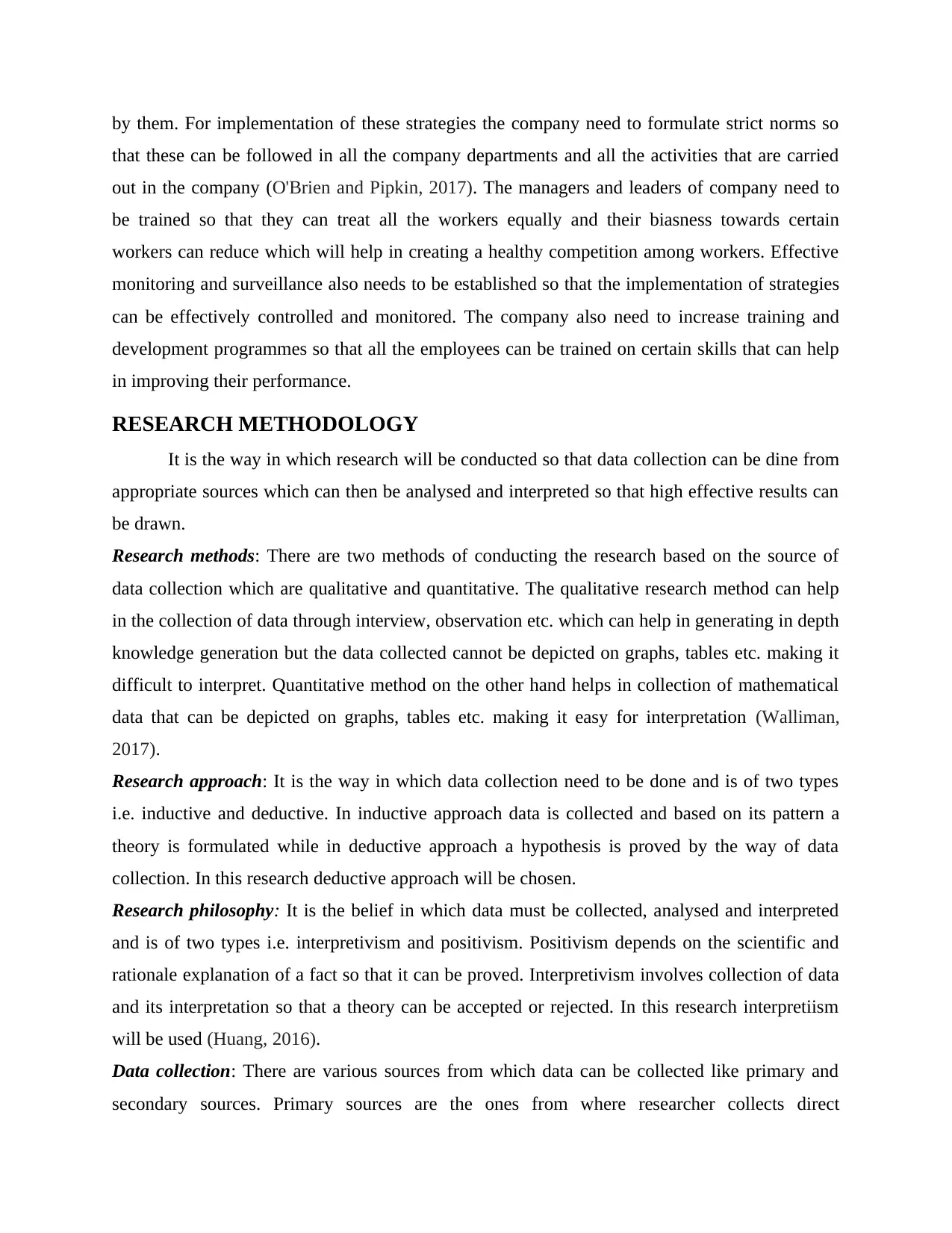
by them. For implementation of these strategies the company need to formulate strict norms so
that these can be followed in all the company departments and all the activities that are carried
out in the company (O'Brien and Pipkin, 2017). The managers and leaders of company need to
be trained so that they can treat all the workers equally and their biasness towards certain
workers can reduce which will help in creating a healthy competition among workers. Effective
monitoring and surveillance also needs to be established so that the implementation of strategies
can be effectively controlled and monitored. The company also need to increase training and
development programmes so that all the employees can be trained on certain skills that can help
in improving their performance.
RESEARCH METHODOLOGY
It is the way in which research will be conducted so that data collection can be dine from
appropriate sources which can then be analysed and interpreted so that high effective results can
be drawn.
Research methods: There are two methods of conducting the research based on the source of
data collection which are qualitative and quantitative. The qualitative research method can help
in the collection of data through interview, observation etc. which can help in generating in depth
knowledge generation but the data collected cannot be depicted on graphs, tables etc. making it
difficult to interpret. Quantitative method on the other hand helps in collection of mathematical
data that can be depicted on graphs, tables etc. making it easy for interpretation (Walliman,
2017).
Research approach: It is the way in which data collection need to be done and is of two types
i.e. inductive and deductive. In inductive approach data is collected and based on its pattern a
theory is formulated while in deductive approach a hypothesis is proved by the way of data
collection. In this research deductive approach will be chosen.
Research philosophy: It is the belief in which data must be collected, analysed and interpreted
and is of two types i.e. interpretivism and positivism. Positivism depends on the scientific and
rationale explanation of a fact so that it can be proved. Interpretivism involves collection of data
and its interpretation so that a theory can be accepted or rejected. In this research interpretiism
will be used (Huang, 2016).
Data collection: There are various sources from which data can be collected like primary and
secondary sources. Primary sources are the ones from where researcher collects direct
that these can be followed in all the company departments and all the activities that are carried
out in the company (O'Brien and Pipkin, 2017). The managers and leaders of company need to
be trained so that they can treat all the workers equally and their biasness towards certain
workers can reduce which will help in creating a healthy competition among workers. Effective
monitoring and surveillance also needs to be established so that the implementation of strategies
can be effectively controlled and monitored. The company also need to increase training and
development programmes so that all the employees can be trained on certain skills that can help
in improving their performance.
RESEARCH METHODOLOGY
It is the way in which research will be conducted so that data collection can be dine from
appropriate sources which can then be analysed and interpreted so that high effective results can
be drawn.
Research methods: There are two methods of conducting the research based on the source of
data collection which are qualitative and quantitative. The qualitative research method can help
in the collection of data through interview, observation etc. which can help in generating in depth
knowledge generation but the data collected cannot be depicted on graphs, tables etc. making it
difficult to interpret. Quantitative method on the other hand helps in collection of mathematical
data that can be depicted on graphs, tables etc. making it easy for interpretation (Walliman,
2017).
Research approach: It is the way in which data collection need to be done and is of two types
i.e. inductive and deductive. In inductive approach data is collected and based on its pattern a
theory is formulated while in deductive approach a hypothesis is proved by the way of data
collection. In this research deductive approach will be chosen.
Research philosophy: It is the belief in which data must be collected, analysed and interpreted
and is of two types i.e. interpretivism and positivism. Positivism depends on the scientific and
rationale explanation of a fact so that it can be proved. Interpretivism involves collection of data
and its interpretation so that a theory can be accepted or rejected. In this research interpretiism
will be used (Huang, 2016).
Data collection: There are various sources from which data can be collected like primary and
secondary sources. Primary sources are the ones from where researcher collects direct
⊘ This is a preview!⊘
Do you want full access?
Subscribe today to unlock all pages.

Trusted by 1+ million students worldwide
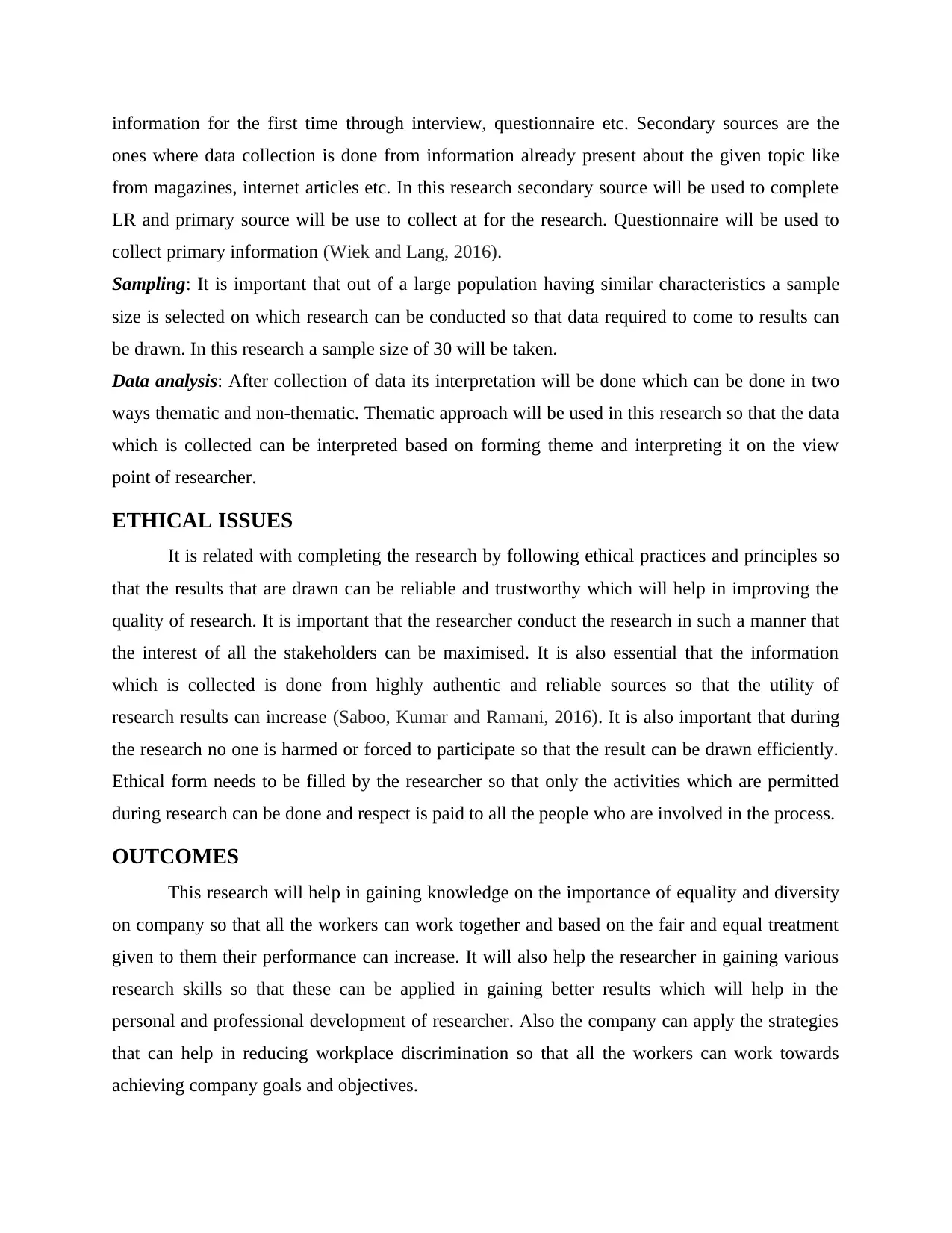
information for the first time through interview, questionnaire etc. Secondary sources are the
ones where data collection is done from information already present about the given topic like
from magazines, internet articles etc. In this research secondary source will be used to complete
LR and primary source will be use to collect at for the research. Questionnaire will be used to
collect primary information (Wiek and Lang, 2016).
Sampling: It is important that out of a large population having similar characteristics a sample
size is selected on which research can be conducted so that data required to come to results can
be drawn. In this research a sample size of 30 will be taken.
Data analysis: After collection of data its interpretation will be done which can be done in two
ways thematic and non-thematic. Thematic approach will be used in this research so that the data
which is collected can be interpreted based on forming theme and interpreting it on the view
point of researcher.
ETHICAL ISSUES
It is related with completing the research by following ethical practices and principles so
that the results that are drawn can be reliable and trustworthy which will help in improving the
quality of research. It is important that the researcher conduct the research in such a manner that
the interest of all the stakeholders can be maximised. It is also essential that the information
which is collected is done from highly authentic and reliable sources so that the utility of
research results can increase (Saboo, Kumar and Ramani, 2016). It is also important that during
the research no one is harmed or forced to participate so that the result can be drawn efficiently.
Ethical form needs to be filled by the researcher so that only the activities which are permitted
during research can be done and respect is paid to all the people who are involved in the process.
OUTCOMES
This research will help in gaining knowledge on the importance of equality and diversity
on company so that all the workers can work together and based on the fair and equal treatment
given to them their performance can increase. It will also help the researcher in gaining various
research skills so that these can be applied in gaining better results which will help in the
personal and professional development of researcher. Also the company can apply the strategies
that can help in reducing workplace discrimination so that all the workers can work towards
achieving company goals and objectives.
ones where data collection is done from information already present about the given topic like
from magazines, internet articles etc. In this research secondary source will be used to complete
LR and primary source will be use to collect at for the research. Questionnaire will be used to
collect primary information (Wiek and Lang, 2016).
Sampling: It is important that out of a large population having similar characteristics a sample
size is selected on which research can be conducted so that data required to come to results can
be drawn. In this research a sample size of 30 will be taken.
Data analysis: After collection of data its interpretation will be done which can be done in two
ways thematic and non-thematic. Thematic approach will be used in this research so that the data
which is collected can be interpreted based on forming theme and interpreting it on the view
point of researcher.
ETHICAL ISSUES
It is related with completing the research by following ethical practices and principles so
that the results that are drawn can be reliable and trustworthy which will help in improving the
quality of research. It is important that the researcher conduct the research in such a manner that
the interest of all the stakeholders can be maximised. It is also essential that the information
which is collected is done from highly authentic and reliable sources so that the utility of
research results can increase (Saboo, Kumar and Ramani, 2016). It is also important that during
the research no one is harmed or forced to participate so that the result can be drawn efficiently.
Ethical form needs to be filled by the researcher so that only the activities which are permitted
during research can be done and respect is paid to all the people who are involved in the process.
OUTCOMES
This research will help in gaining knowledge on the importance of equality and diversity
on company so that all the workers can work together and based on the fair and equal treatment
given to them their performance can increase. It will also help the researcher in gaining various
research skills so that these can be applied in gaining better results which will help in the
personal and professional development of researcher. Also the company can apply the strategies
that can help in reducing workplace discrimination so that all the workers can work towards
achieving company goals and objectives.
Paraphrase This Document
Need a fresh take? Get an instant paraphrase of this document with our AI Paraphraser
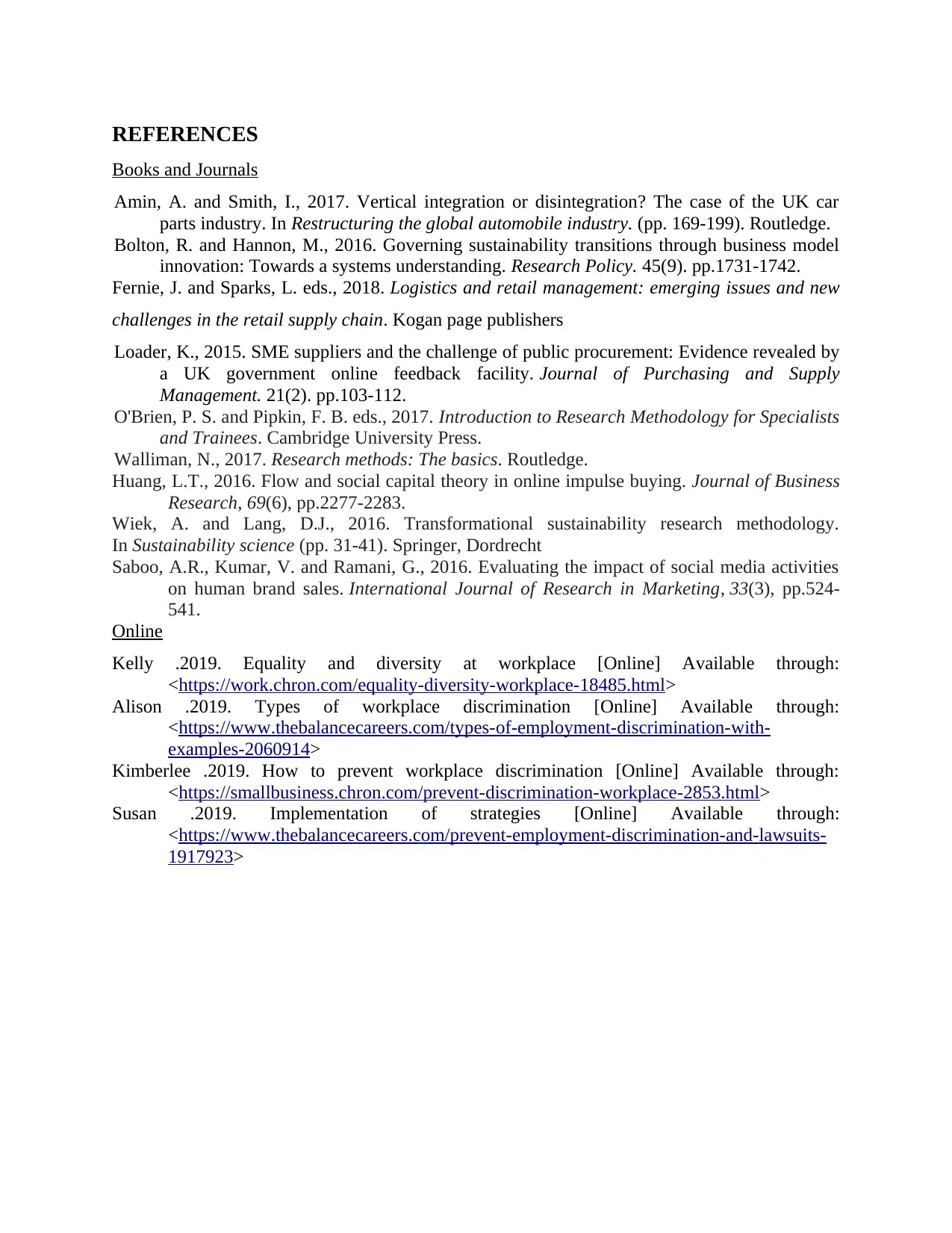
REFERENCES
Books and Journals
Amin, A. and Smith, I., 2017. Vertical integration or disintegration? The case of the UK car
parts industry. In Restructuring the global automobile industry. (pp. 169-199). Routledge.
Bolton, R. and Hannon, M., 2016. Governing sustainability transitions through business model
innovation: Towards a systems understanding. Research Policy. 45(9). pp.1731-1742.
Fernie, J. and Sparks, L. eds., 2018. Logistics and retail management: emerging issues and new
challenges in the retail supply chain. Kogan page publishers
Loader, K., 2015. SME suppliers and the challenge of public procurement: Evidence revealed by
a UK government online feedback facility. Journal of Purchasing and Supply
Management. 21(2). pp.103-112.
O'Brien, P. S. and Pipkin, F. B. eds., 2017. Introduction to Research Methodology for Specialists
and Trainees. Cambridge University Press.
Walliman, N., 2017. Research methods: The basics. Routledge.
Huang, L.T., 2016. Flow and social capital theory in online impulse buying. Journal of Business
Research, 69(6), pp.2277-2283.
Wiek, A. and Lang, D.J., 2016. Transformational sustainability research methodology.
In Sustainability science (pp. 31-41). Springer, Dordrecht
Saboo, A.R., Kumar, V. and Ramani, G., 2016. Evaluating the impact of social media activities
on human brand sales. International Journal of Research in Marketing, 33(3), pp.524-
541.
Online
Kelly .2019. Equality and diversity at workplace [Online] Available through:
<https://work.chron.com/equality-diversity-workplace-18485.html>
Alison .2019. Types of workplace discrimination [Online] Available through:
<https://www.thebalancecareers.com/types-of-employment-discrimination-with-
examples-2060914>
Kimberlee .2019. How to prevent workplace discrimination [Online] Available through:
<https://smallbusiness.chron.com/prevent-discrimination-workplace-2853.html>
Susan .2019. Implementation of strategies [Online] Available through:
<https://www.thebalancecareers.com/prevent-employment-discrimination-and-lawsuits-
1917923>
Books and Journals
Amin, A. and Smith, I., 2017. Vertical integration or disintegration? The case of the UK car
parts industry. In Restructuring the global automobile industry. (pp. 169-199). Routledge.
Bolton, R. and Hannon, M., 2016. Governing sustainability transitions through business model
innovation: Towards a systems understanding. Research Policy. 45(9). pp.1731-1742.
Fernie, J. and Sparks, L. eds., 2018. Logistics and retail management: emerging issues and new
challenges in the retail supply chain. Kogan page publishers
Loader, K., 2015. SME suppliers and the challenge of public procurement: Evidence revealed by
a UK government online feedback facility. Journal of Purchasing and Supply
Management. 21(2). pp.103-112.
O'Brien, P. S. and Pipkin, F. B. eds., 2017. Introduction to Research Methodology for Specialists
and Trainees. Cambridge University Press.
Walliman, N., 2017. Research methods: The basics. Routledge.
Huang, L.T., 2016. Flow and social capital theory in online impulse buying. Journal of Business
Research, 69(6), pp.2277-2283.
Wiek, A. and Lang, D.J., 2016. Transformational sustainability research methodology.
In Sustainability science (pp. 31-41). Springer, Dordrecht
Saboo, A.R., Kumar, V. and Ramani, G., 2016. Evaluating the impact of social media activities
on human brand sales. International Journal of Research in Marketing, 33(3), pp.524-
541.
Online
Kelly .2019. Equality and diversity at workplace [Online] Available through:
<https://work.chron.com/equality-diversity-workplace-18485.html>
Alison .2019. Types of workplace discrimination [Online] Available through:
<https://www.thebalancecareers.com/types-of-employment-discrimination-with-
examples-2060914>
Kimberlee .2019. How to prevent workplace discrimination [Online] Available through:
<https://smallbusiness.chron.com/prevent-discrimination-workplace-2853.html>
Susan .2019. Implementation of strategies [Online] Available through:
<https://www.thebalancecareers.com/prevent-employment-discrimination-and-lawsuits-
1917923>
1 out of 8
Related Documents
Your All-in-One AI-Powered Toolkit for Academic Success.
+13062052269
info@desklib.com
Available 24*7 on WhatsApp / Email
![[object Object]](/_next/static/media/star-bottom.7253800d.svg)
Unlock your academic potential
Copyright © 2020–2025 A2Z Services. All Rights Reserved. Developed and managed by ZUCOL.





